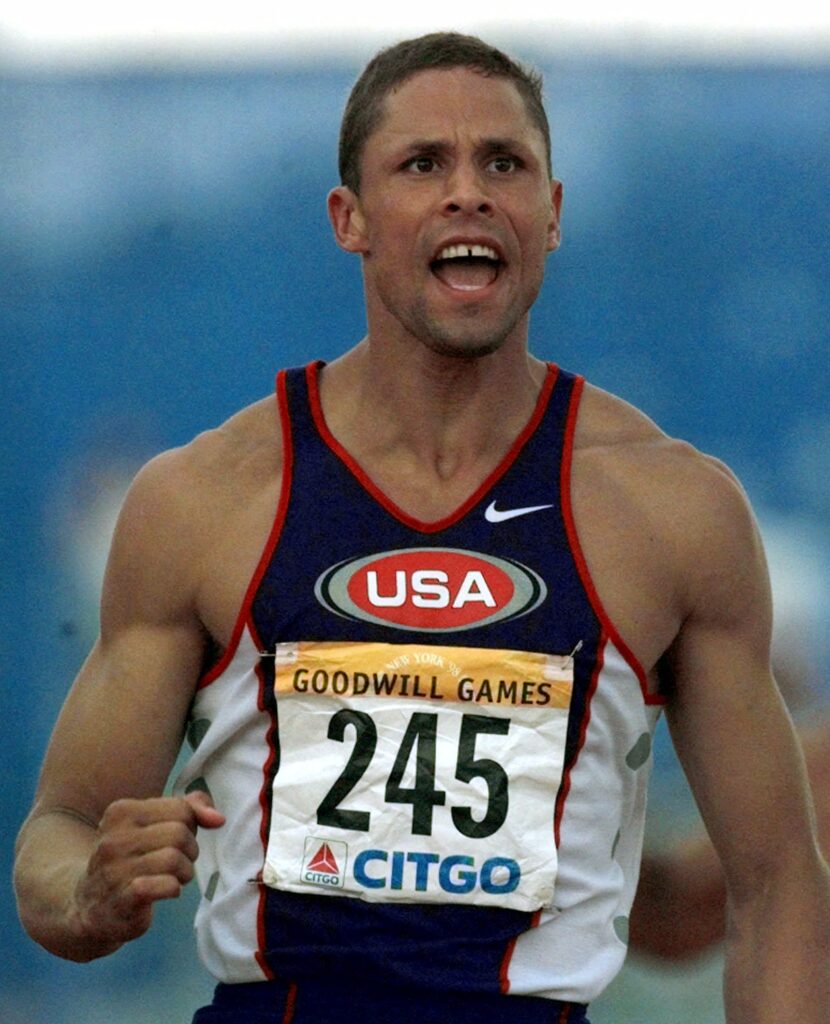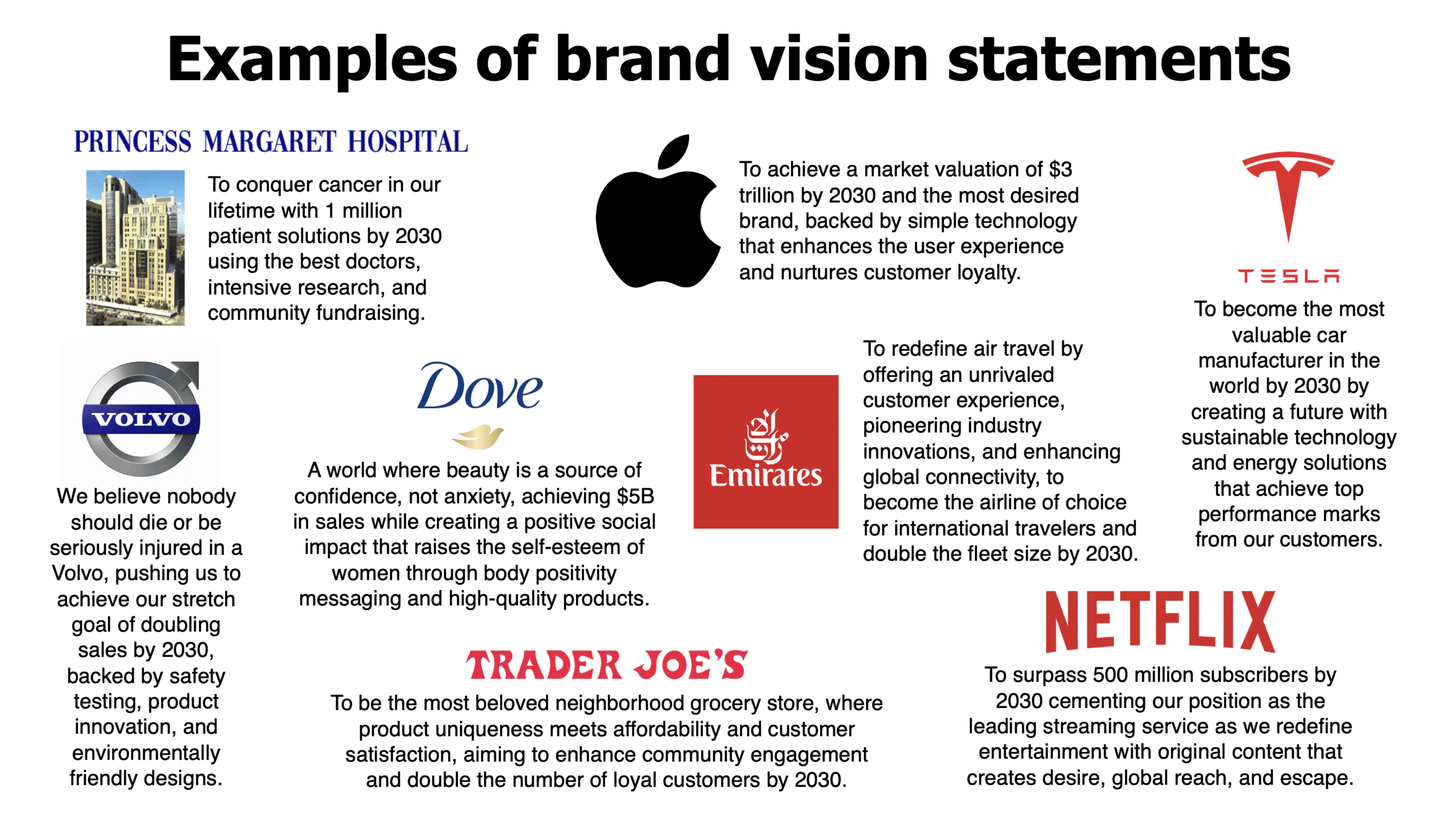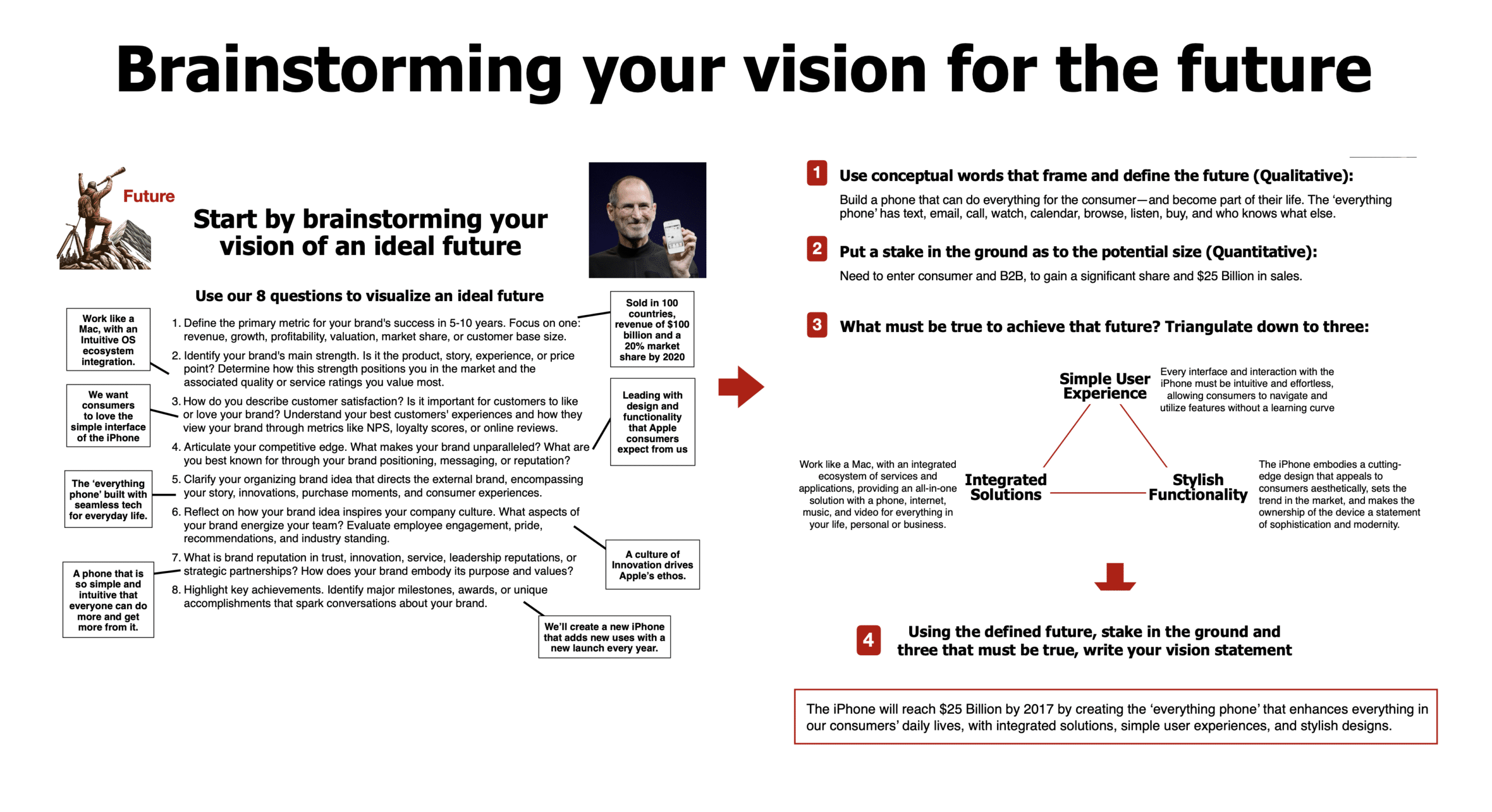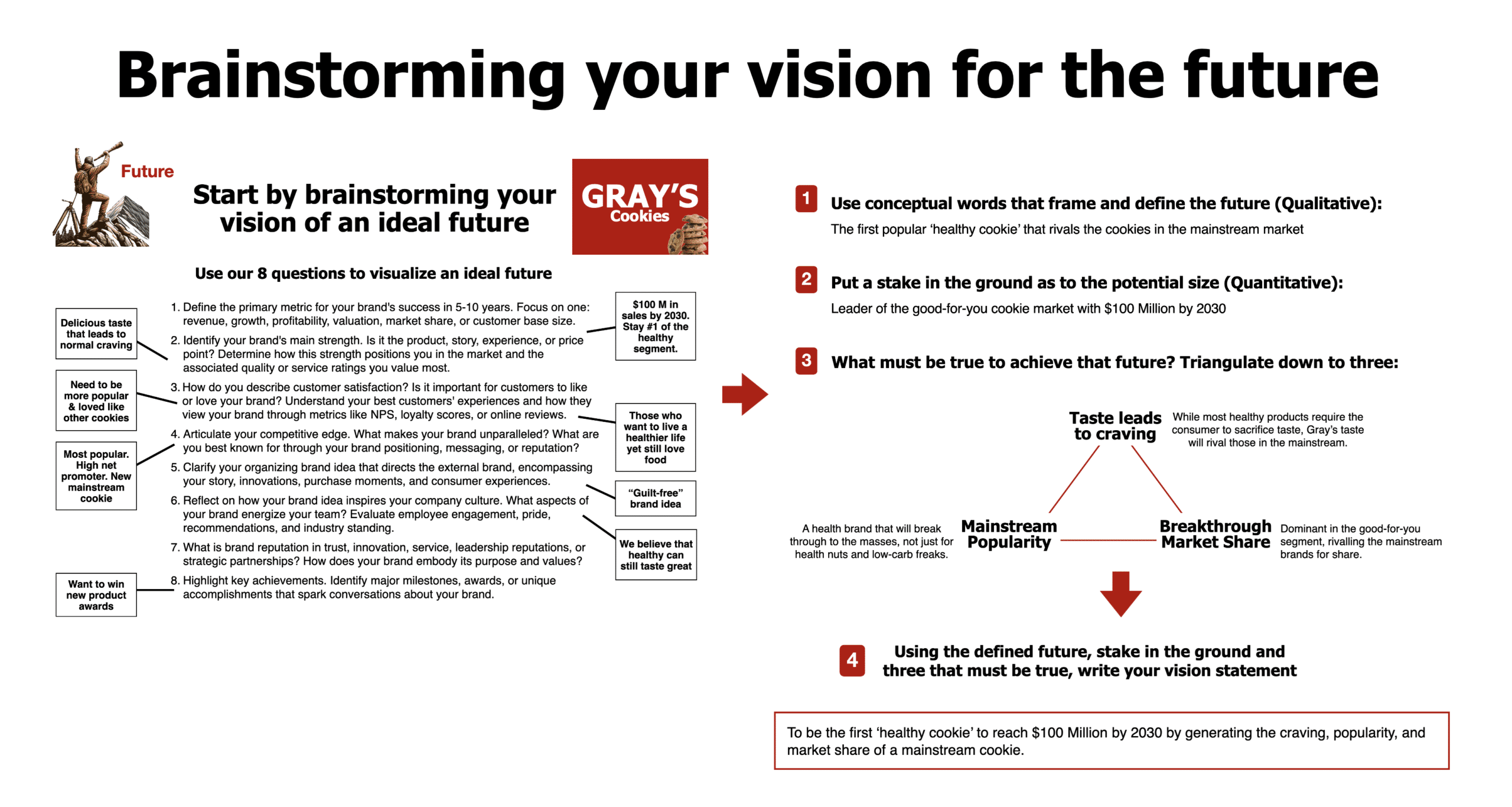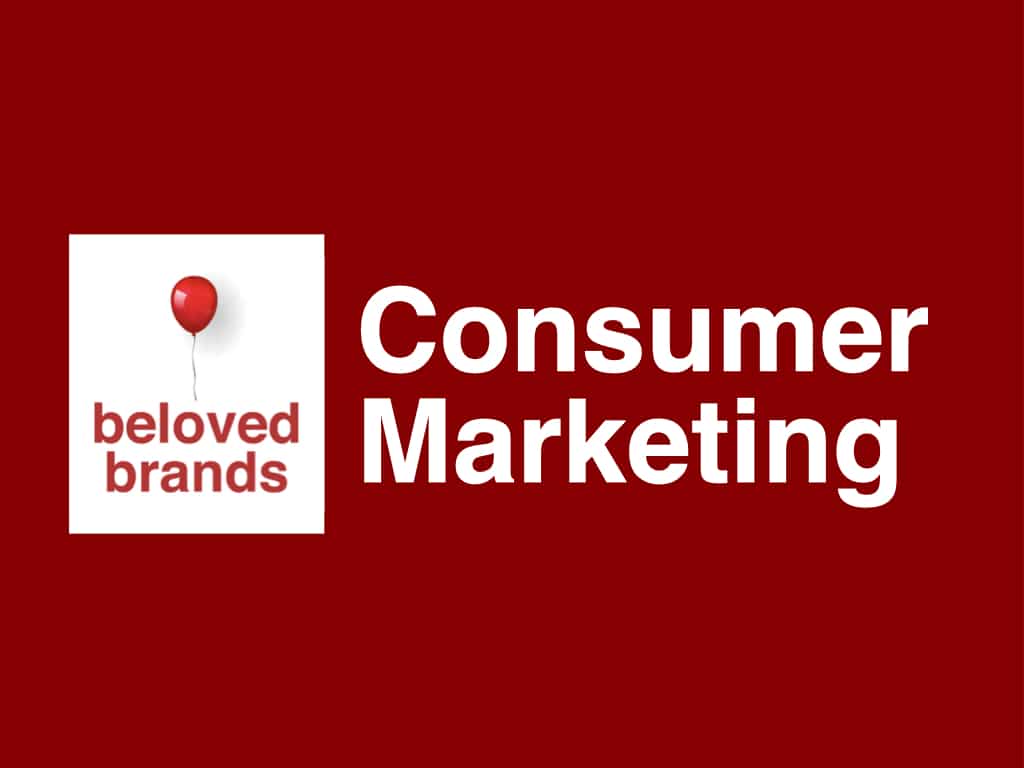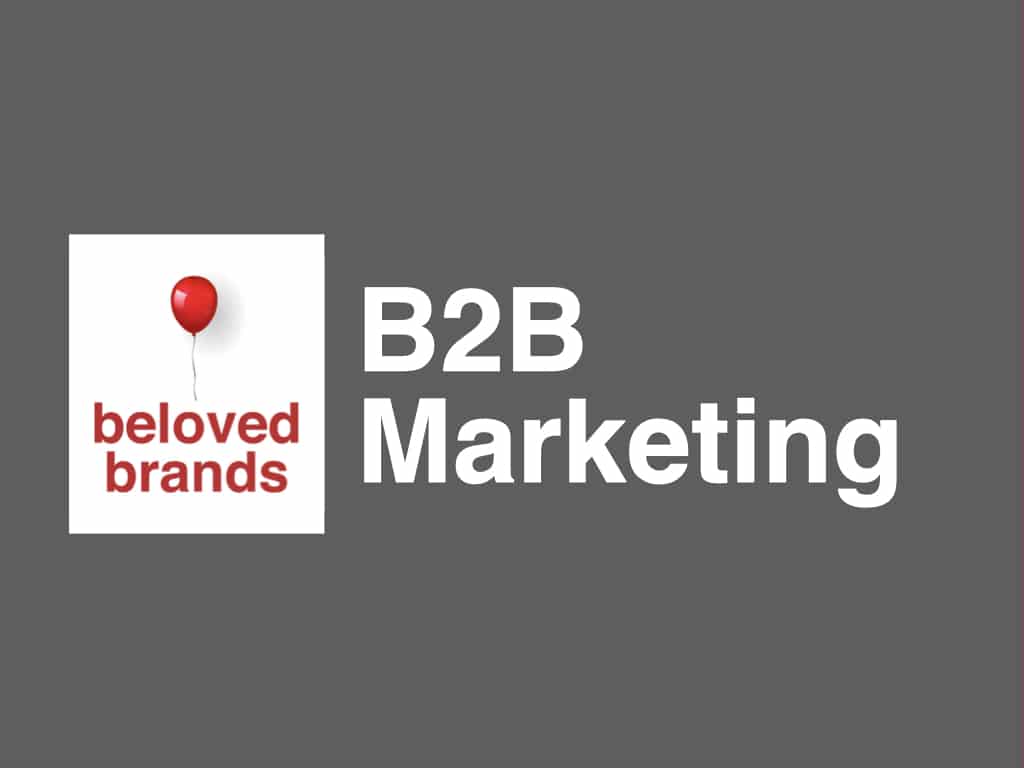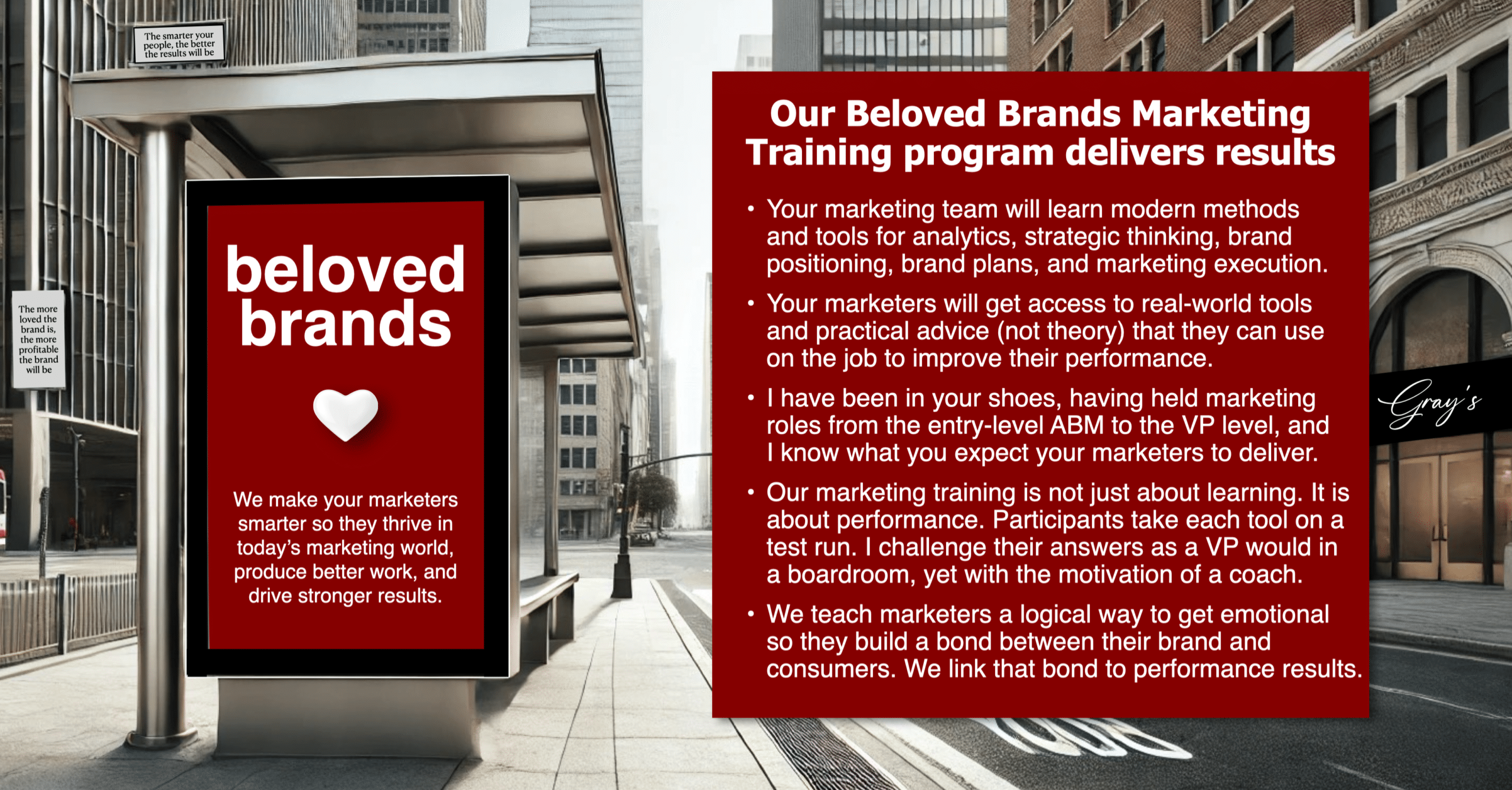A well-written brand vision should be the ultimate end-in-mind achievement, which answers, “Where could we be?” Use these examples of brand vision statements to inspire you as you write your own vision statement. Maybe you will see something that feels familiar to what is in your mind or at least a structure for how you would write your own vision statement.
Think about significant accomplishments that would make you feel completely fulfilled. Put a stake in the ground to describe an ideal state for your future. Every smart brand plan must start with a brand vision statement. When I see brand teams who struggle, they usually lack a brand vision.
“If you don’t know where you are going, you might not get there.” Yogi Berra
Some organizations get so fixated on achieving short-term goals; they chase every tactic in front of them just to make their numbers. Your vision should steer your entire brand plan. Choose the language and phrases within your vision that will inspire, lead, and steer your team.
Focusing your vision statements
Your vision should scare you a little and excite you a lot. You should wonder if you can achieve it and then think of how it would feel if you did. While we do not always accomplish every vision, we rarely achieve more than we thought was possible.
Once you establish your vision, it sets up the key issues of your plan, including obstacles in the way of achieving your vision, which then sets up the strategies for how to reach the vision. As mentioned earlier, a brand plan has to flow like an orchestra, with each element directly related to the others.
Imagine the perfect picture
To be a visionary, you must be able to visualize your future. You should be able to imagine the perfect picture of your brand in the future, to helps answer, “Where could we be?” Imagine it is five or ten years from now. You wake up in the most fantastic mood. Think about where you are in your personal life and your business life. Start to imagine an ideal state of what you want. Visualize a perfect future of what has you in such a good mood and write down the most important things you want to achieve.
- Define the primary metric for your brand’s success over the next 5-10 years. Choose one key indicator: revenue, growth, profitability, valuation, market share, or customer base size.
- Identify your brand’s main strength. Is it the product, story, experience, or price point? Determine how this strength positions you in the market and the associated quality or service ratings you value most.
- How do you describe customer satisfaction? Is it important for customers to like, or love your brand? Understand your best customers’ experiences and how they view your brand through metrics like NPS, loyalty scores, or online reviews.
- Articulate your competitive edge. What makes your brand unparalleled? Pinpoint what you’re best known for through your brand positioning, messaging, or reputation.
- Clarify your organizing brand idea that directs the external brand, encompassing your story, innovations, purchase moments, and consumer experiences.
- Reflect on how your brand idea inspires your company culture. What aspects of your brand energize your team? Evaluate employee engagement, pride, recommendations, and industry standing.
- Examine your corporate persona. Consider your reputation in trust, innovation, and service alongside CSR efforts, leadership reputations, and strategic partnerships. How does your brand embody its purpose and values through sustainability, discoveries, or advancements?
- Highlight key achievements. Identify major milestones, awards, or unique accomplishments that spark conversations about your brand.
Use these questions to brainstorm what's important to your vision
Let’s use the 2007 iPhone launch as an example.
Use conceptual words that frame and define the future (Qualitative).
- Steve Jobs wanted to build a phone that could do everything for the consumer—and become part of their life. He wanted to combine a phone, a computer, and an iPod. The iPhone would become the ‘everything phone’ with text, email, phone, watch, calendar, browser, music, and buy. And, who knows what else.
Put a stake in the ground for the potential size (Quantitative).
- Continuing with the iPhone, they needed to enter consumer and B2B to drive $25 billion in sales within ten years. That was an extremely ambitious stretch goal, given that Blackberry had yet to crack the $1 billion mark.
To illustrate, click to zoom in.
What must be true for the iPhone to achieve that in the future?
Triangulate down to three:
- Apple knew they had to reach the masses to reach such a stretch goal. Blackberry mainly used its products for business executives. Apple’s iPod and Mac work taught them how to reach the masses. Here are the three elements that must be true for the iPhone to reach its vision:
Simple user experience:
- Every interface and interaction with the iPhone must be intuitive and effortless, allowing consumers to navigate and utilize features without a learning curve.
Integrated solution:
- They wanted the iPhone to work like the Mac, with an integrated ecosystem of services and applications. This provides an all-in-one solution with a phone, internet, music, and video for everything in your life, personal or business. They created Apps to serve as mini-software.
Stylish Functionality:
- To meet consumers’ expectations of an Apple product, the iPhone must embody a cutting-edge design that appeals to consumers aesthetically. This sets the trend in the market. Moreover, it makes the device’s ownership a statement of sophistication and modernity.
Putting everything together to create a vision statement.
Write your vision statement by putting everything together, using the defined future, stake in the ground, and three that must be true. The brand vision statement for the iPhone launch of 2007 was:
“The iPhone will reach $25 Billion by 2017 by creating the ‘everything phone’ that enhances everything in our consumers’ daily lives, with integrated solutions, simple user experiences, and stylish functionality.”
Video: Marketing in about 60 seconds -How to write the brand vision
Checklist for what makes a vision great:
- Your vision should last 5-10 years.
- It should help you imagine the ideal picture of “where could we be.”
- Describe your dream, describing what you see, feel, hear, think, say, and wish for your brand.
- It should be emotional to motivate all employees and partners to rally behind it.
- It must be easy to understand, in plain words, which may already be a familiar phrase within the company.
- A great vision is a balance between aspiration (stretch) and reality (achievement).
- Consider adding a financial (sales or profit) or share leadership position (#1) number.
Vision for Gray's Cookies
Using the eight questions above to discuss with your team, look for commonality in your answers and then use conceptual words to frame and define the future, which becomes the qualitative part of the vision. For Gray’s Cookies, the first part of the vision is to be “the first popular healthy cookie that rivals the cookies in the mainstream market.”
Next, put a stake in the ground as to the potential size, which becomes the quantitative part of the vision. For Gray’s, the second part of the vision is to be “the leader of the good-for-you cookie market with $100 Million by 2030.”
The third element of the vision is a triangulation of what must be true to achieve that future. For Gray’s Cookies, the three elements that must be true are
- Taste leads to craving:
- Mainstream Popularity
- BreakthroughMarket Share
Using our technique, the ideal vision statement for Gray’s Cookies should be:
To be the first ‘healthy cookie’ to reach $100 Million by 2030 by generating the craving, popularity, and market share of a mainstream cookie.
Writing your vision with three ‘what must be true’ elements provides clues to set up the key issue questions of what’s in the way of us achieving that vision. Below, we can see the iPhone’s key issues related to a simple user experience, integrated solutions, and stylish functionality.
Your vision should scare you a little and excite you a lot. You should wonder if you can achieve it and then think of how it would feel if you did. While we do not always accomplish every vision, we rarely achieve more than we thought was possible.
Once you establish your vision, it sets up the key issues of your plan, including obstacles in the way of achieving it, which then sets up the strategies for how to reach it. A brand plan has to flow like an orchestra, with each element directly related to the others.
Cautions and caveats when writing your brand vision statements:
- A vision should not be a positioning statement.
- Make sure you have not already achieved it.
- Do not make strategic statements. It is not the “how.”
- Try to be single-minded. Keep tightening it. Do not include everything!
- Focus on how to build a purpose-driven beloved brand
We believe that marketers learn best when they see our marketing concepts applied to brands that look like their own. We have come up with specific examples – consumer, B2B and healthcare – to showcase our marketing tools. Click on the icon below to choose your interest area.
An interesting story about coming up with your vision
Dan O’Brien was a U.S. track and field superstar back in the 1990s. He competed in the Decathlon and won pretty much everything: World Champion, Olympic Champion, US Champion, and World Record Holder that would stand for 10 years–a lifetime in the track and field world. His story will inspire you.
